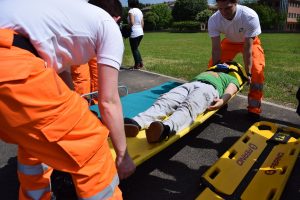By Zach Boggs

We can all agree that having employees trained in CPR and First aid techniques is a good investment of time and money. But when providing training, are we truly doing all we can to prepare ourselves for a medical emergency?
As a CPR instructor working in the field of safety and loss control, I hear horror stories from class participants and contacts about situations that didn’t go as planned. Many times, it’s due to a lack of preparation and could have been prevented. An example of this is not having adequate PPE to protect yourself from bodily fluids or opening a first aid kit only to find the contents have been used and not replaced. Providing CPR/First Aid training is a great step but its only one piece of the puzzle. To have a solid response, additional planning is needed for not only the responders but the general population as well. Below are three steps to help you fine-tune your response and feel confident in your efforts.
Plan
During the opening comments of my CPR/First Aid courses we spend some time discussing preparedness, and I always urge the attendees to have a follow-up meeting after the class to discuss the specifics and lay out their plan. Each place of business is different and poses unique challenges to the responders. Items that should be covered in this meeting include:
- Local EMS response times and capabilities;
- Potential accidents and worst-case scenarios (Cardiac Arrest, Amputations, etc.);
- Employees who have special needs;
- Coverage for shifts;
- Defined roles for employees; and
- Ensuring responders have access to needed supplies and equipment to handle situations that may arise.
Another key component of emergency preparedness is ensuring our equipment and supplies are functional and well maintained. While conducting inspections I routinely identify disabled eyewash stations and AED’s with expired batteries or pads. Many times, employees are under the impression that someone else is attending to these critical tasks. Having a meeting and laying out a detailed plan many of these potentially catastrophic mistakes can be avoided.
Communicate
Communication is a vital component of an effective emergency response. All employees should be aware of the response efforts that have been put in place for their benefit and have a clear understanding of their role. Make employees aware of:
- Locations of equipment and supplies such as AEDs and First Aid kits;
- Response team members; and
- Protocols for alerting the response team.
It’s very important to reiterate that all non-responders stay in their designated areas during emergencies to prevent confusion and crowding in the area. This should start at the time of hire by incorporating pertinent information into the orientation process. and should be discussed at least annually with the entire workforce.
Audit
To keep your emergency response sharp:
- Conduct periodic audits of equipment and procedures;
- Perform routine inspections on equipment such as AED’s, eyewash stations, and first aid kits to ensure functionality;
- Keep an inventory of supplies and promptly replace any used or expired items;
- Conduct tabletop exercises with the response team to discuss and critique procedures;
- Keep skills fresh by conducting a periodic drill with responders; and
- Conduct follow up meetings to discuss areas for improvement after drills or real-life emergencies.
Providing CPR/First Aid training is a great first step, but by developing a plan, communicating with employees and frequently auditing your response efforts you can take your emergency response to the next level and greatly improve your chances for success.

